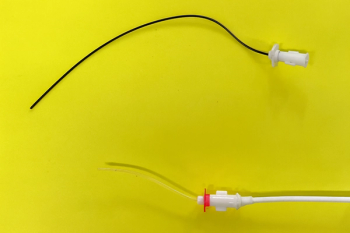
Research Update: Transurethral lithotripsy in dogs: A minimally invasive option for urolith removal?
Urolithiasis commonly affects dogs and can cause dysuria, stranguria, hematuria, pyuria, and an obstructive uropathy.
Urolithiasis commonly affects dogs and can cause dysuria, stranguria, hematuria, pyuria, and an obstructive uropathy. While surgical removal of uroliths has been traditionally performed in animals, laser lithotripsy is more frequently used in people because of reduced morbidity and complications.
In this retrospective case series of 73 dogs (45 males, 28 females) treated at two veterinary teaching hospitals, the use and outcome of transurethral cystoscope-guided laser lithotripsy for fragmentation of cystic and urethral uroliths were described. The dogs' median weight was 19.6 lb (8.9 kg) in females and 22.2 lb (10.1 kg) in males. Male dogs weighing < 11 lb (5 kg) were excluded from the study because of the inability for retrograde passage of a 2.7-mm-diameter ureteroscope.
Laser lithotripsy resulted in complete fragmentation of all uroliths in all female dogs and in 86.7% of the male dogs. In the remaining male dogs, a cystotomy was required to remove the uroliths. Dogs with urethroliths had a median procedure time of 70 minutes, while dogs with cystic uroliths had a median procedure time of 105 minutes. Dogs with both cystic and urethral uroliths had a median procedure time of 153 minutes.
Complications of lithotripsy occurred in nearly 18% of female dogs and about 13% of male dogs. The most common (five dogs) complication was urethral swelling, which occurred during or within 24 hours of the procedure and required urinary catheterization. The authors concluded that laser lithotripsy was a safe, successful, and minimally invasive procedure for treating canine uroliths.
COMMENTARY
In dogs, cystic and urethral stones have most often been removed by cystotomy and normograde and retrograde flushing of the urethra. The results of this study highlight the advantages (e.g. short procedure time, minimal complications, successful stone fragmentation) of a minimally invasive approach in a university teaching hospital setting. While probably not feasible for general practitioners, the technique should be considered on a referral basis for animals in poor health that are at risk for a prolonged anesthetic time or open abdominal or urethral surgical approach, that have undergone multiple surgeries, or that may have urogenital tract neoplasia. It will be interesting to note if the duration of the procedure and complication rate can be further reduced as more technical experience is gained.
Adams LA, Berent AC, Moore GE, et al. Use of laser lithotripsy for fragmentation of uroliths in dogs: 73 cases (2005-2006). J Am Vet Med Assoc 2008;232(11):1680-1687.
The information in "Research Updates" was provided by Veterinary Medicine Editorial Advisory Board member Joseph Harari, MS, DVM, DACVS, Veterinary Surgical Specialists, 21 E. Mission Ave., Spokane, WA 99202.
Joseph Harari, MS, DVM, DACVS
Newsletter
From exam room tips to practice management insights, get trusted veterinary news delivered straight to your inbox—subscribe to dvm360.



